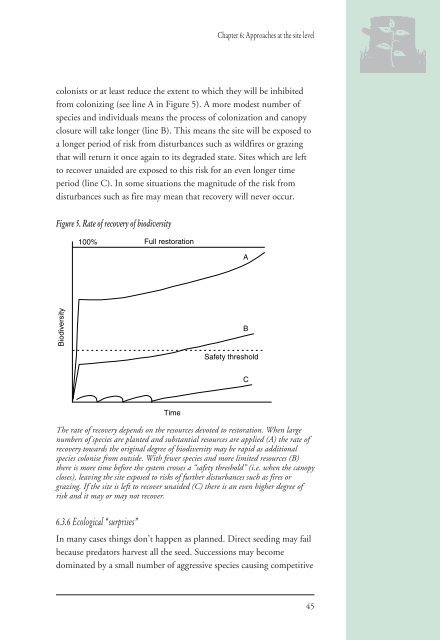Rehabilitation and Restoration Of Degraded Forests (PDF) - IUCN
Rehabilitation and Restoration Of Degraded Forests (PDF) - IUCN
Rehabilitation and Restoration Of Degraded Forests (PDF) - IUCN
You also want an ePaper? Increase the reach of your titles
YUMPU automatically turns print PDFs into web optimized ePapers that Google loves.
Chapter 6: Approaches at the site level<br />
colonists or at least reduce the extent to which they will be inhibited<br />
from colonizing (see line A in Figure 5). A more modest number of<br />
species <strong>and</strong> individuals means the process of colonization <strong>and</strong> canopy<br />
closure will take longer (line B). This means the site will be exposed to<br />
a longer period of risk from disturbances such as wildfires or grazing<br />
that will return it once again to its degraded state. Sites which are left<br />
to recover unaided are exposed to this risk for an even longer time<br />
period (line C). In some situations the magnitude of the risk from<br />
disturbances such as fire may mean that recovery will never occur.<br />
Figure 5. Rate of recovery of biodiversity<br />
Biodiversity<br />
100%<br />
Full restoration<br />
Time<br />
Safety threshold<br />
The rate of recovery depends on the resources devoted to restoration. When large<br />
numbers of species are planted <strong>and</strong> substantial resources are applied (A) the rate of<br />
recovery towards the original degree of biodiversity may be rapid as additional<br />
species colonise from outside. With fewer species <strong>and</strong> more limited resources (B)<br />
there is more time before the system crosses a “safety threshold” (i.e. when the canopy<br />
closes), leaving the site exposed to risks of further disturbances such as fires or<br />
grazing. If the site is left to recover unaided (C) there is an even higher degree of<br />
risk <strong>and</strong> it may or may not recover.<br />
6.3.6 Ecological “surprises”<br />
In many cases things don’t happen as planned. Direct seeding may fail<br />
because predators harvest all the seed. Successions may become<br />
dominated by a small number of aggressive species causing competitive<br />
A<br />
B<br />
C<br />
45

















